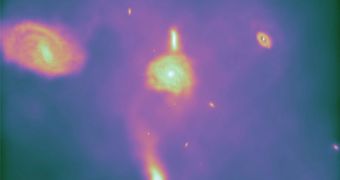An international collaboration of experts announces the development of an innovative computational model that is capable of simulating and monitoring the birth, evolution and eventual demise of thousands of galaxies over billions of years.
Created by American researchers at the Harvard-Smithsonian Center for Astrophysics (CfA) and German colleagues from the Heidelberg Institute for Theoretical Studies (HITS), the new software, called Arepo, is bound to make galactic studies easier and more reliable.
Perhaps the most important implication of the new research is that it's now possible to construct an entire Universe from scratch, populate it with galaxies, and then watch how these objects interact.
CfA investigator Mark Vogelsberger says that the computational approach can be used to mimic all galaxy types ever detected in real life. In addition, its parameters can be modified so that they include the laws of physics, as well as the influences of both dark matter and dark energy.
An important capability programmer Volker Springel (HITS) included in Arepo is tracking the background glow left behind in the Cosmos by the Big Bang. From this starting point, the software creates galaxies, and then tracks their evolution for roughly 14 billion years.
Past simulations were unable to produce spiral galaxies, like the Milky Way, the Pinwheel, and the Andromeda galaxies. By cleaning up previous codes, the team was able to remove this limitation.
“Our simulations improve over previous ones as much as the Giant Magellan Telescope will improve upon any telescope that exists now,” CfA research scientist Debora Sijacki explains. “We took all the advantages of previous codes and removed the disadvantages,” Springel adds.
The GMT is scheduled to be completed by 2020. When operational, it will be the largest telescope in the world, at least twice more capable than any other optical/near-infrared observatory
A significant improvement Arepo brings over other simulation software is that it divides space inside the model it constructs into a grid, rather than many tiny cubes of fixed dimensions. This allows it to model space after the motions of gas, stars, galaxies, dark matter and dark energy, like in real life.
Arepo requires 1024 processor cores, and runs on the Odyssey high-performance supercomputer, at the Harvard University. A total of 14 billion years were simulated in just a few months, experts say.
Over the next few months, the research team plans to conduct similar, but more comprehensive, simulations of the Universe, modeling a much larger volume. This will enable them to study galactic evolution in even more detail.

 14 DAY TRIAL //
14 DAY TRIAL //